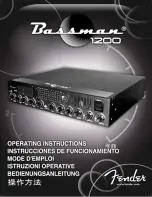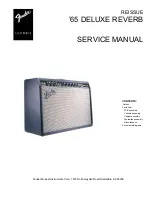
Calibration — Type Z
five half cycle of the waveform by using the + Internal
position of the Triggering Mode switch. Adjust L7645, L8645,
L7632, and L8632 to obtain the sharpest negative leading
corner on the displayed waveform without introducing any
overshoot (see Fig. 5-7). Adjust each pair of variable in
ductors (for example, L7645 and L8645) in equal increments
so the slugs are positioned the same depth in the coil forms.
Disconnect the signal from the B input connector and
apply it to the A input connector. Set the Mode switch
to A O N LY. Set the oscilloscope Trigger Slope switch to
— Internal to display the positive half cycle of the w ave
form. Check to see if the leading corner of the positive
going waveform is as square as possible without overshoot.
If it is not, adjust the coil slugs for a compromise between
the best display obtained with signal applied to the B
input connector and that obtained when connected to the
A input connector. The compromise setting assures that
the best possible high-frequency differential operation will be
attained.
Disconnect the square-wave generator cable and the
termination.
C A L . 1
C A L . 2
C A L . 3
C A L . 5
C A L . 4
F ig , 5 - 8 . Top v ie w of the Z U n it sh o w in g lo catio n of step 1 7 test
p o in ts a n d in te rn a l a d ju stm en ts.
16. Bandwidth Measurement
Apply a 50-kc sine-wave from the Type 190A Constant-
Amplitude Signal Generator (or equivalent) to B input
connector. Set the oscilloscope Time/cm switch to the .1
millisec position and free run the sweep. Adjust the gen
erator amplitude control so that the signal produces exactly
28 mm (2.8 cm) of deflection on the crt. Center the display
vertically on the screen.
Increase the sine-wave generator frequency to 13 me,
keeping the generator output level constant. (The Type
190A Generator maintains a constant-amplitude signal auto
matically.)
After the generator frequency has been increased to
13 me, (3 db point), there should be at least 20 mm (2 cm)
of deflection.
If another type of Tektronix oscilloscope is being used
with the Z Unit to make a bandwidth check, consult the
Specifications section of this manual for the upper frequency
limit. That is the frequency at which 20 mm of deflection
or more should be obtained. For instance, if a Type 535A
Oscilloscope is used in conjunction with the Z Unit, 20 mm
or more should be obtained with the sine-wave generator
set at 10 me.
Disconnect the generator from the B input connector
and apply the signal to the A input connector. Set the
Mode switch to A O N LY and repeat this step. Disconnect
the sine-wave generator.
17. Precision Voltage Adjustments
Remove the Z Unit and connect an EP54 plug-in extension
between the unit and oscilloscope. Set the COMPARISON
VO LTA G E Polarity switch to + . Make certain the CO M
PARISON V O LTAG E Range switch is set to 100 V. Before
proceeding with this step, be sure the regulated power
supply voltages measured in the oscilloscope are within
specifications as noted in the preliminary calibration in
structions. Refer to Fig. 5-8 for locations of all test points
and internal adjustments given in this step.
(a) Adjust CAL. 1:
Set the
precision voltmeter for
— 107.70 volts and connect it between Test Point A and
ground. Adjust CAL. 1 (R8674) for a null reading on the
meter.
(b) Adjust CAL. 2:
Set the
precision voltmeter for
+ 107.70 volts. Place the COMPARISON V O LTAG E Polar
ity switch in the — position. Adjust CAL. 2 (R7671) for a
null reading on the meter.
N O TE
W hen adjusting C A L. 1 and C AL. 2 w irew ound
controls, it is more im portant that the voltage
readings be id e n tical, than that they be e xa ctly
1 0 7.7 volts. For instance, readings of — 1 0 7 .9 0
and
+ 1 0 7 .9 5 are better than — 1 0 7 .7 0 and
+ 1 0 7 .8 5 . Keep the two vo ltag e readings within
the range o f 107.3 to 108.1 volts, how ever.
(c) Adjust CAL. 3: With the precision voltmeter set for
+ 107.7 volts, connect it between Test Point B and Ground.
Set the COMPARISON V O LTAG E Polarity switch to the
+ position. Adjust CAL. 3 (R7681) for a null indication on
the meter. (If CAL. 1 and CAL 2 adjustments are set at
107.9 or any other voltage reading within limitations given
in step 17b, then CAL. 3 should set at the same voltage).
(d) Adjust CAL. 4:
Set the precision voltmeter for
+ 100.00 volts and connect it between Test Point C and
ground. Adjust CAL. 4 (R7684) for a null reading on the
meter.
(e) Adjust CAL. 5:
Set the COMPARISON VO LTAGE
Range switch to 10 V and the precision voltmeter for
10.000 volts. Adjust CAL. 5 (R7689) for a null reading on
the meter. Because of interaction between CAL. 4 and CAL.
5, repeat these adjustments until readjustment is no longer
necessary.
(f) Check 1 Volt Range: Set the COMPARISON VOLT
A G E Range switch to 1 V and the precision voltmeter for
1.0000 volts. The meter should be within 5 millivolts of
null.
O r conversely, null the voltmeter by turning the
®
5-6
Summary of Contents for TYPE Z PLIG-IN
Page 14: ...OVERALL G A IN 2 PUSH PULL I OUTPUT l I l Ci I Fig 3 1 Type Z Plug In Unit block diagram 3 0...
Page 18: ...NOTES Type Z...
Page 24: ...NOTES Type Z...
Page 32: ...NOTES...
Page 36: ...0 Parts List Type Z RIGHT SIDE 0 6 4...
Page 38: ...Parts List Type Z LEFT SIDE 6 6...
Page 44: ...NOTES...
Page 52: ......
















































